#(sheep are also in caprinae)
Explore tagged Tumblr posts
Text
Misleading names image is from here:
I have just learned that Mountain Goats are NOT, in fact, actual Goats.
#we love you mountain chicken#also mountain goats are *related* to goats in that they're in the same family (bovidae) and subfamily (caprinae)#(sheep are also in caprinae)#but all goats are in the genus capra and mountain goats are in the genus oreamnos‚ which is on a different branch within caprinae#i guess that branch is sometimes referred to as 'goat-antelopes'#so yeah they're not true goats but they're in the same subfamily#taxonomy#mountain goats#animals#art#that art is super cute
213K notes
·
View notes
Note
oh my god what is the Creature in your pinned post pls I’ve never seen it before what a beautiful beast

My all-time favorite animal!
It's a Takin (Budorcas taxicolor), a large Caprine native to Bhutan, India, China and Tibet.
despite sharing a similar appearance with and being within the subfamily caprinae with the Muskox (Ovibos moschatus), Takins are more closely related to sheep.

There is an interesting myth behind the creation of the Takin (Budorcas Taxicolor) that contributed to its high religious significance and therefore led to its adoption as Bhutan’s national animal.
Legend has it that in the 15th century when Lam Drukpa Kunley also referred to as “The Divine Madman” arrived in Bhutan from Tibet he delivered religious teachings to the people whereupon they requested him to conjure up a miracle. He agreed on the condition that he would be fed lunch – a whole cow and a whole goat.
Doing as he commanded, the people offered him his massive lunch. The Tibetan saint devoured the flesh of both the animals and left out the bones. Then he fixed the head of the goat onto the body of the cow and with a snap of his fingers uttered a mantra. The animal instantly sprung to life and began grazing on the meadows. He then named it the “Dong Gyem Tsey” (Takin).

#ask#takin#bovidae#i love all ungulates soo much but i will take any chance i get to gush about takins#golden takin#sichuan takin
932 notes
·
View notes
Note
Are there any animals from Earth that you'd think would be fun to see on Pandora? Extinct or not, just for fun
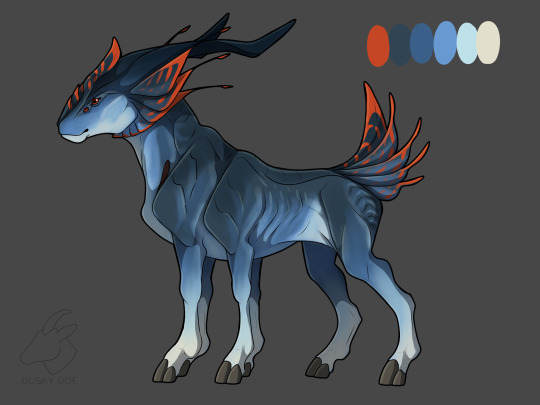
Some kinda Caprinae (wild goat/sheep etc) analogue for sure!! We didn't get to see much of the mountain biome beyond the ikran rookery, but i'm sure there's some terrestrial creatures bouncing around up there if the na'vi can get there from the ground. Maybe the ikran would even hunt these guys in a similar way that golden eagles sometimes hunt chamois and ibex!
I also just really like goats, and I think the pandoran ecosystem could do with more mid-sized herbivores :)
#avatar pandora#avatar movies#avatar movie#avatar#avatar 2009#pandora avatar#pandora#asks#digital art#digital painting#my art#duskys art
55 notes
·
View notes
Text
redacted demon horn hcs i came up with so i dont have to change my demon designs 💕
within every demon race there are horn variations so they dont all end up having same horn syndrome (like same face syndrome in art but with horns 👍)
empathy — most common variation are the ram horns, most rare are the inverse ram horns. empathy daemon's horns will always be small and will always be in the capridae family
sadism — most common variation are the gazelle horns, least common are the curved gazelle horns. sadism demon's horn will always be large and tall
shock — most common variation are the gemsbok horns, least common variation are the four-horned antelope horns. shock demon's horns will always be pointed straight up, as if in "shock"
inchoate — inchoates have multiple horn variations, so it is hard to pinpoint the rarity of each variant. the most common come down to the indian bison horns, bharal horns, and a set of "classic" demon horns with two smaller horns protruding from the base
fear — most common variation are the greater kudu horns, most rare the the blackbuck horns. sizes always vary, and horns will always be swirled in some way, with the exception of the unicorn horn varient
misery — most common variation are the tibetan argali horns, most rare are the bighorn sheep horns. misery demons' horns will always fall in the capridae family
elation — most common variation are the ibex horns, most rare are the red hartebeest horns. sizes can vary, but usually are medium
serenity — most common variation are horns that belong to an animal that are most likely related to bharals, most rare are the fallow antlers. serenity daemons, interestingly, have horn variations that belong to two separate families: caprinae and cervidae. while the cervidae antlers have more variation, the mysterious bharal-like horn variant is still the most common. serenity daemons are also the only daemon race outside of empathy daemons to have digigrade legs
strife — most common variant are the eland horns, most rare are the addax horns (which sometimes results in a strife demon being mistaken for a sadism or fear demon). a more uncommon yet well-known variation is the triple horn set
desire — similarly to inchoate demons, desire demons have a multitude of horn variations, the most common being the markhor horns and "classic" demon horns paired with a small set of ram horns
#did i meticulously search up what animal each horn belonged to?#yes. yes i did.#and i found all of them except for serenity :(#if anyone knows what animal serenity belongs to please lmk#redacted asmr#redactedverse#redacted audio#redacted demons#redacted headcanons#vinn yapping#vinn says fandom things#vinn says really dumb stuff#vinn headcanons things
62 notes
·
View notes
Note
-whispers- you've stumbled upon my trap card: caprinae lore- Perhaps only the bravest of sheeps n goats venture into the caves... a right of passage even, to show bravery against the beasts that would hunt the flock and steal away young lambs in the spring. Their reward? s a l t. oh and pride in facing their fears but cmon, the salt's the real reward here.
Knowing goats/sheeps it'd be funny if the way to return sillybilly lamb was just...salt. Hold up a salt lick. silly billy sticks their tongue out and fixes on it like a missile-(they crave that mineral-)
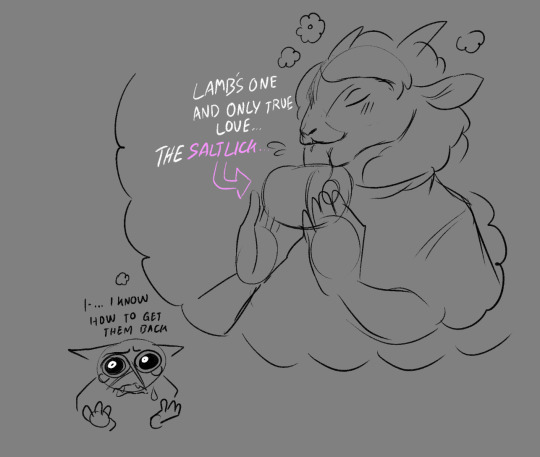
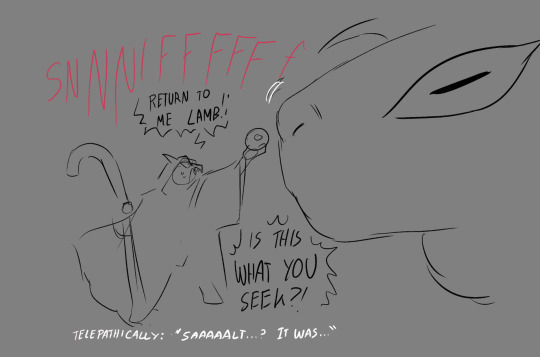
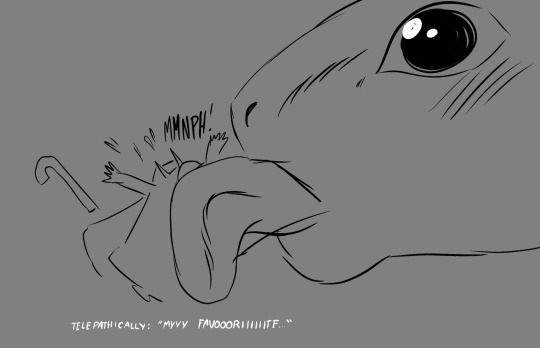
i drew this in such a rush holy god this idea is brilliant
#-skitters around my cave like a hooligan-#i LIKE WORLD BUILDING OLD SHEEP/GOAT LORE#i have too many thoughts for one sillybilly lamb#but also lamb climbing up a sheer cliff face for salt lives rent free in my head#narinder just “THE HELL ARE YOU DOING”#“getting that mineral”#cult of the lamb#cotl#hi im the anon XD#i have too much caprinae knowledge if its not apparent-
765 notes
·
View notes
Text
The Goat is a Scapegoat
Since I’m writing this before the update, so still don’t know WHAT THE HECK IS GOaT’S DEAL LIKE WHAT EVEN ARE THEY? I’m just analyzing the symbolism.

I think the Goat (I like to call them Billie) is not a goat for no reason. Obviously, goats are very heavily associated with demons and the occult, which is kinda this game’s whole thing.
But, I don’t think the Goat is just some generic sabbatic goat, I think the Goat is specifically meant to be a scapegoat.
The Lamb is literally a sacrificial lamb (which is a metaphor of someone that is sacrificed for a greater good, e.g. Jesus “Lamb of God” Christ. And our player character’s story in the game is based on that. Lamb’s first death was for the “greater good” of the Old Faith, and every death after that was again for the sake of someone else [Narinder]. You only later get to take fate back into your own hands by refusing to be sacrificed again.).
So, it’d make sense if player 2 the Goat is also inspired by existing religious/occultic symbolism and metaphor. Out of all the associations goats have, scapegoat makes the most sense to me. A scapegoat is someone who is sacrificed to absolve another of sin. It’s similar enough to the concept of the sacrificial lamb to work as a foil while still being interestingly distinct.
(Which, by the way, I’ve seen some people imagining what players 3 and 4 might look like, but it’s always just another caprinae? An antelope? I feel like the fact goats and sheep are related is coincidental, Massive Monster is going for the sacrificial animals/satanic symbolism here. Player 3 and 4 would be a bull {Moloch} and a snake.)
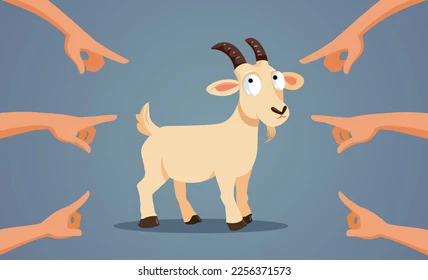
In my head cannon, the Goat wasn’t sacrificed by the bishops to prevent a prophecy, their death was not meant to avert some wrath from an avenging death god. But they sure as heck were hunted.
In Goat’s universe, Narinder (who is a doggy, of course) is never imprisoned, so there was no prophecy. Even so, the Bishops are still cursed by their sin, guilty of acts so profane and unnatural they are unforgivable except by death. They committed a horrible crime against Shamura, the most innocent, who cared for and raised each of them as if they were their own spiderlings, Shamura is the one they love most of all.
So intense is the Bishops’ guilt and regret, so pure their sin, it’s begun to eat away at them and physically deform them, blinding, muting, deafening, maddening, paralyzing. And it corrupts their divine domains, where there were once benevolent gods of Peace, Plenty, Healing, Knowledge, and Death, there are now bitter gods of Chaos, Famine, Plague, a-and Death still —but, like, even scarier death!
Since the only way to be absolved of such a crime is to die, and they don’t wanna do that, they must find a surrogate to die in their stead. So they blame it on some random vulnerable minority. The goats! So they genocide all the goats until there was only one left, “the Goat”, who now both metaphorically and literally holds all the gods’ sins. With their death, the bishops' atonement shall finally be complete.
Yeah, except that Shamura, corrupted into the fell mad god of war, has not forgiven them, so makes the Goat their undying Vessel and sends them to deliver just punishments and executions to the four bishops.
As to why the Goat is helping the Lamb? While Lamb is a messianic figure, Goat is a sin-eater. The Goat can never escape their nature of being a perpetual scapegoat, always taking on the guilt and responsibility of others, whether they want to or not. Forced to swallow the sin of four dark gods, burdened by it since the very moment they were born, certainly can’t have any positive effects on the soul, metaphysically and psychologically. Even though they’ve cleansed themself of sins in a baptism of divine ichor, that cavernous void it left in their heart will just refill again.
Why could I not save the goats? Why did I sacrifice so many of my own followers?
No matter what choices the Goat makes, they will always feel guilty about something, because they have never gotten to know what it’s like to be allowed to be innocent.
Perhaps, by walking their path a second time, by atoning twice, by helping another in a similar position to themself, by dying repeatedly in their stead on the field of battle, Goat will finally be free.
Goat never kills Shamura since that would not redeem them, it would not allow them to stop being a scapegoat like how it allowed Lamb to stop being a sacrificial lamb. That would only be possible through enlightenment, by finally internalizing that it was never their fault.
Then again, maybe Goat is just a heckin’ weirdo who really likes fighting and mogging sheep. They are the chosen vessel of war, after all.
88 notes
·
View notes
Note
Will Ramamba and Teufletoot be in your gobb rewrite
(OKAY UHHHH HI IM SORRY IT TOOK ME SO LONG TO GET TO THESE ASKS SO ILL JUST BE SPEEDRUNNING THROUGH THEM YEAHHHHHHH)
Both Ramamba AND Truffletoot will be present within AASB!
I'm still currently working through what their exact roles will be in the rewrite, since we currently do not fully know Ramamba and Truffletoot's current roles in canon GoBB (since GoBB 0 is a prequel). All I know so far is that Ramamba will likely be another antagonist while Truffletoot is an ally.
Ramamba will likely be changed from being a ram to being an ibex, since Banbaleena is already a sheep. If youre curious, in AASB, Banban is a goat, Banbaleena is a sheep, and Flumbo is a takin (ibexes, goats, sheep, and takin are all part of the subfamily Caprinae, connecting all four of them together).
Although I'm not particualry sure about it, I'm playing around with the idea that Banban, Banbaleena, and Flumbo are all technically Ramamba's children, since the three of them are actually triplets in my rewrite. You see, in the timeline of AASB, there were three different 'generations' of sucsessful experiments at the facility, with some of the first-generation experiments being used to create some of the second-generation experiments. Ramamba, Sir Dadadoo, Queen Bouncelia, and Syringeon were all first-generation experiments. Banban, Banbaleena, and Flumbo were all second-generation experiments. The naughty ones and the Syringeon babies were also second-generation experiments.
Additionally, I feel like Ramamba was one of the few successful experiments to NOT have a mascot based on themselves be used in the kindergarten, alongside Zolphius and a few other experiments for several different reasons. Overall, I think Ramamba will be a huge threat against the protagonists within AASB, we'll just have to wait and see.
Moving on to Truffletoot. I feel like he would instead work as an ally in AASB, though wouldn't appear until later in the story. Instead of being a mushroom, Truffletoot would instead be a slug, with some added DNA of some kind of bioluminescent animal, hence why he glows. The 'mushrooms' that grow on him would actually be large tumors and deformed flesh, and he's in quite a bit of pain as a result. Overall, he would just be a little sweetie whose gone through a lot, poor guy.
#gobb#garten of banban#garten of banban redesign#garten of banban rewrite#GoBB: As Above So Below#ramamba#truffletoot#asks#send me asks
7 notes
·
View notes
Note
i think it would be cute to have the reader contrast executor by being sweet and approachable! as for race, i know you were sort of throwing it out there that the series might be in the same 'continuity' of sorts as cor novum, but if that were the case, then (at least canonically), the doctor is implied to be something close to human. i think you said you weren't around for babel, and that's when that was brought up. but if you did want to go with making the reader a terran race, whether because they're not the doctor or because you don't really need to stick to canon, i think a caprinae reader might be fun! i'd say aegir for lore reasons, but many of them don't have obvious traits... (also, i'm just realizing that i called executor "exe" in my last ask because i'm so used to seeing it on the blog even though it's what you go by- my bad!) - 🎶 anon

🎶 anon aaa!! It's v v good to see you again in my inbox abhshss hiya!! 🥹🫶 I hope you've been well!!!
I hope you don't mind me getting back to you by combo-ing your two asks ansjsjs 🙏
First of all!! TYSM for replying about my yapping about a 'Rico anthology aabahahah!!! 🥹🤲💕 I appreciate your thoughts and interest v v much!
So!! AAA your words about my writing for Federico.... Ansjsjs 🎶 anon!!! 😭🥹 Tysm! That means v v much to me... My lil heart aaaushhsa 😖🫶 he means v v much to me so that the love is palpable... Lolosjsisjs ty v v much!!! 😭🤲🩵
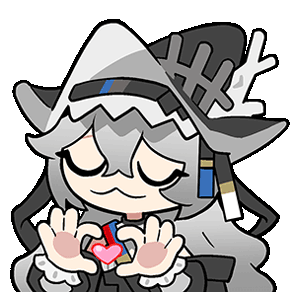
But anywho! About the actual Federico-reader for this proposed series!!!
I haven't caught up on Babel properly yet sgshshs but I've caught up on the Wiki and through my friends!! ⭐ So I sort of know what the deal is with where doctor came from!! But! I think I definitely want to divert from canon a bit!! And maybe even the continuity of 'Cor Novum'!! (by that I mean, I wonder if reader should stay the Doctor... Or be an Operator?? Sbsjhs?? Any thoughts?)
I think a Caprinae reader would be sbshshs v v cute!! Tysm for the suggestion omg!! I love the symbolism there.... A sheep with an angel slosksjsks 😭🙏 and there would be lots of potential for interesting plot for reader, since Caprinae have a superiority in Originium Arts and also they sometimes get mistaken for Sarkaz absjshs...!!
You mentioned Ægir too and sbsjshs I have to admit, could you enlighten me about what lore reasons you mean sbshshs...? 🥹🤲 (I know a little about the Atlantis thing, and ofc the thing with the presence of the Lateran faith in Iberia where many Ægir are from, though I'm not sure if those are what you meant aaa?) but for Ægir!! They do have pointed ears normally, which I think would be a cute trait for reader to have 🥹💕
Anywho sgshshs!! Please excuse my yapping... Tysm for sharing your thoughts it means v v much to me!! I really love being able to use your guys' ideas in my writing aaa... Feels sort of like a collaboration 🥹🤲🩵
Tysm for your ask 🎶 anon! And again it was v v good to see you, I hope you'll stick around!! 💕 Please remember to take care of yourself and have a great day 💘~
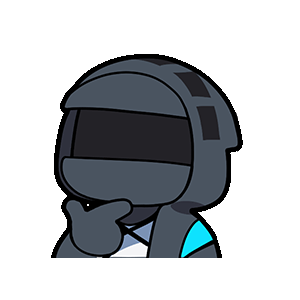

Always remember: 'Rico and Exe love you sbshhs!! 🫶
#A sweet sheep reader sbshhss is a v v cute idea for him 🥹💕 or even a more mischievous sheep... Absjbsjns#arknights#arknights imagines#not an imagine#arknights x reader#inbox#inbox reply#anon#anon reply#exe's anons 🎶 anon
6 notes
·
View notes
Text
i have. some very strong opinions on this one.
what is the difference between a sheep and a goat?
goat and ram are not interchangable words. they are two different species. a ram is a male sheep, whereas a goat is its own species.
there are a couple of different ways to tell the difference!
first, look at the tail! sheep's tails hang down, while goat tails stick up! (images are a sheep and then a goat):

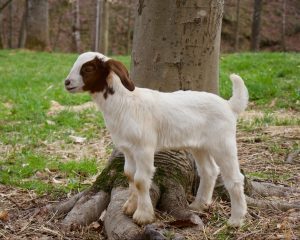
this is because sheep tails are docked! (aka they naturally have longer tails that are cut shorter (which for sheep is done to prevent disease)) here's what they look like undocked:

you can also look at their horns! female sheep (ewes) don't have horns, and some domestic sheep breeds don't naturally have horns, but when rams do have horns they're usually thicker and more curved than goat horns (ram and then goat):


goats also typically have a little goatee! (ram then goat):
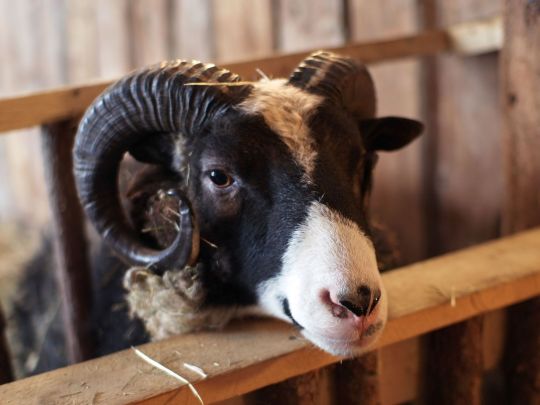
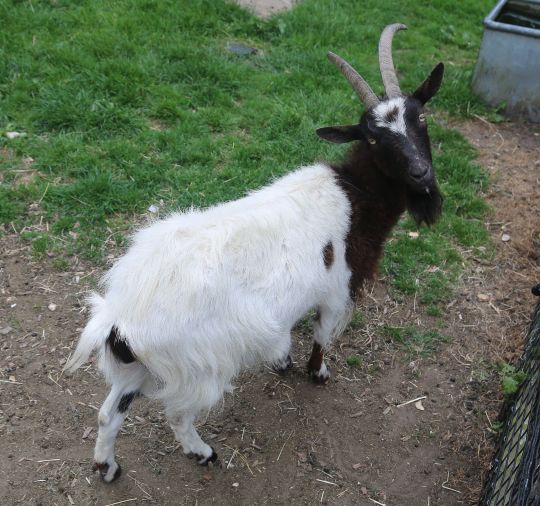
there's a couple other nuances to tell the difference between the two, (eg sheeps' split upper lip), but these are the most obvious!
#lmao infodump but. i am a ram enjoyer who is sick of ppl calling rams sheep#i am personally a toba ram truther#razias shadow#razia's shadow#toba the tura#razias shadow toba the tura
12 notes
·
View notes
Text
Ganaderia
La ganadería, o actividad pecuaria, consiste en la cría, cuidado y explotación de animales domésticos con fines de producción, como carne, leche, huevos, lana, entre otros, para consumo humano o comercialización.
En detalle:
Definición:
La ganadería es una actividad del sector primario que se enfoca en la cría, cuidado y reproducción de animales domésticos, con el objetivo de obtener productos para el consumo humano o para la comercialización.
Importancia:
Es una fuente importante de alimentos, como carne, leche, huevos, y otros productos derivados de los animales.
Tipos de ganadería:
Ganadería bovina: Cría de vacas para obtener carne y leche.
Ganadería porcina: Cría de cerdos para obtener carne.
Ganadería avícola: Cría de aves para obtener carne y huevos.
Ganadería ovina: Cría de ovejas para obtener carne y lana.
Ganadería caprina: Cría de cabras para obtener carne y leche.
Ganadería en México:
Se producen grandes cantidades de carne de res, cerdo, pollo, leche y otros productos ganaderos.
México es un importante exportador de carne de res y otros productos ganaderos.
La ganadería mexicana es una actividad importante que contribuye a la economía y a la seguridad alimentaria del país.
La ganadería mexicana también enfrenta desafíos, como la necesidad de mejorar la sostenibilidad y la eficiencia de la producción.
Impacto ambiental:
La ganadería tiene un impacto significativo en el medio ambiente, y es importante buscar formas de hacerla más sostenible.
FAO:
La Organización de las Naciones Unidas para la Alimentación y la Agricultura (FAO) trabaja para transformar los sistemas ganaderos para que sean más sostenibles, productivos y resilientes.
Here is the translation:
Livestock farming, or animal husbandry, consists of breeding, caring for, and exploiting domestic animals for production purposes, such as meat, milk, eggs, wool, among others, for human consumption or commercialization.
Details:
Definition:
Livestock farming is a primary sector activity focused on the breeding, care, and reproduction of domestic animals, with the goal of obtaining products for human consumption or commercialization.
Importance:
It is an important source of food, such as meat, milk, eggs, and other animal-derived products.
Types of livestock farming:
Cattle farming: Breeding cows to obtain meat and milk.
Pig farming: Breeding pigs to obtain meat.
Poultry farming: Breeding poultry to obtain meat and eggs.
Sheep farming: Breeding sheep to obtain meat and wool.
Goat farming: Breeding goats to obtain meat and milk.
Livestock farming in Mexico:
Mexican livestock farming is an important activity that contributes to the country's economy and food security.
Large quantities of beef, pork, chicken, milk, and other livestock products are produced.
Mexico is an important exporter of beef and other livestock products.
Mexican livestock farming also faces challenges, such as the need to improve sustainability and production efficiency.
Environmental impact:
Livestock farming has a significant environmental impact, and it is important to seek ways to make it more sustainable.
FAO:
The Food and Agriculture Organization of the United Nations (FAO) works to transform livestock systems to be more sustainable, productive, and resilient.
Let me know if you would like any adjustments or additional information.
2 notes
·
View notes
Text
Wild Equestria AU
Here is the introductory post for my Wild Equestria AU, as well as where links to everything posted will be saved (click to get to know more)
First: What is the WE AU?
It is something I've been working on ever since I was a kid, the basics are that Equestria is expanded with a lot more mythological creatures existing
Also the Everfree Forest spans over most of Equestria (which in this instance is the land Solis (my Celestia) and Luna rule over, it's just one country on the planet of Terra, there are many more

Here is pretty much the updated map with just the extra forest added in
There are small communities wherever the forest will allow, most often found in clearings. Of course there are also spaces that a normal creature won't perceive, hidden spaces within these woods, that not even Queen Solis knows the existence of...
The small, known communities are connected via train and can be travelled to via air, though that is a hugely dangerous journey to make
The weather is, as in canon, not controllable in the forested area, though weather creatures can work above the clearings and the spaces outside the woods
Second: Sapience of creatures
There are many sapient races on the planet of Terra, so much eveny that it'd be easier to nane the ones that aren't
Certain livestock animals like pigs and chickens aren't sapient, while cows, goats and sheep are
The animals of our world all exist, and besides equines, and the exceptions named above, aren't generally sapient
Though there do exist sapient counterparts, for example in felines there are our common housecats as well as wild cats like tigers, but also a race of catcreatures simply called the felidae folk. They can appear both bipedal (see Capper) and quadrupedal
As the AU moves forward we'll probably encounter all sorts of animals and their sapient counterparts
Also there have been many more sapient mythological creatures added that we will meet as we go along
Third: The thing about cutiemarks
All equine, bovine, bovidae, cervidae and caprinae creatures can gain cutiemarks and also have children with one another
These species can also have children with mythological species that are at least part one of the named types of races
They can also procreate with dragons, though their fertility is already very low, and just worsens in cross species relationships
There may of course be overall hurdles in procreation, no matter if the species are technically compatible (for example too big a size difference)
Helpful information:
Naming Conventions
The Pony Races
The Elements of Harmony
Twilight Star Sparkle
> Family tree
> Ascension
Rarity Belle
> Family tree
Honey Crisp Apple (AJ)
> Family tree
Rainbow Dash
> Family tree
Pink Tourmaline Pie (Pinkie)
> Family tree
Butterfly Ixora Shy (Fluttershy)
> Family tree
0 notes
Text
It is occurring to me the sheer amount of ungulates that’s in my vbros animal stuff
The ventures are the obvious culprits, being goats. But that means that the extended parts of that messed up family tree are also part of caprinae in some way. The monarch is a goat, with his mother also being one (considering making his dad an ibex) and Dermott is a goat-sheep (appearing slightly more like a sheep), with the rest of the fictels being sheep
And that’s just the ventures, I haven’t drawn him yet but red death and his daughter are horses
And now I need to deliver the big bomb drop. Whales and dugongs are considered ungulates. Check wiki I’m being dead serious. That means wide wale and Dr dugong are also part of the amount of ungulates
Fuck having the majority of your animal au cast being dogs or cats. I’ve made most of them ungulates
0 notes
Text
The funny thing about the mountain goats are not goats but musk ox are comment is that because both species are in the same subfamily (caprinae) which goats and sheep are also in they are both equal levels of goat and not goat and not goat so if you consider musk oxen to be goats you have to consider mountain goats to be goats too.
0 notes
Text
🦍Markhor’s menagerie masterpost🦌
🦧Primates🐒
.
Primate kin
Colugos. Not quite primates, but I love them anyway.
.
Basal primates
Basal animals are those which are closer to the base of a particular section of the tree of life. A more traditional word for this concept is primitive. So for example, amphibians are basal land vertebrates. Here I have classified basal primates as any which are not monkeys and/or apes, including Strepsirrhini and Tarsiiformes.
Lemurs
A group of basal primates found exclusively on the island of Madagascar.
.
New world monkeys
Monkeys which are native to the “new world”, or the Americas. They are the only non-human primates found here. It is thought they arrived to the Americas tens of millions of years ago, when a group of African monkeys were blown out to sea by a storm. They survived the journey across the Atlantic on a natural raft of floating vegetation, and founded a new group of primates: Platyrrhini.
.
Old world monkeys
These are monkeys native to the “old world”: Africa and Eurasia. Also known as Cercopithecidae.
.
Apes
A group of large old world monkeys most recognisable by their lack of a tail. More formally known as Hominoidea.
Lesser apes
Consists of all the gibbon species, found in the treetops all across Southeast Asia.
Great apes
Includes orangutans, gorillas, chimpanzees, and humans. All living species of great ape have been documented using tools.
🐫Ungulates🐃
.
Odd-toed ungulates
Odd-toed ungulates, of course, have an odd number of hooves. They include horses, tapirs, rhinos, and their extinct relatives. They might actually be less closely related to even-toed ungulates than you’d think!
.
All ungulates from here on out are Even-toed ungulates:
These have an even number of hooves, and include most living hoofed mammals. Whales are technically included in this group, but they’re best left for another time.
.
Camelidae
Consists of camels, llamas, and their extinct relatives. They are often adapted for harsh climates such as deserts and mountains.
.
Pigs, hippos, & kin
This isn’t a “real” group, but I’ve put them together to make classifying extinct species simpler. This includes peccaries, pigs, hippos, and a bunch of related extinct animals. Whales are also in here, but again, are best left for another time.
.
All ungulates from here on out are Ruminants:
Ruminants are a group of even-toed ungulates with a robust digestive system to get as much nutrition as possible out of their food. They will regurgitate their food in order to chew it again, in a process called chewing the cud.
.
Chevrotains
Also known as mouse deer, these are the smallest of all ungulates.
.
Protoceratids
A strange group of extinct ungulates, once found in North America.
.
Giraffes & kin
Pronghorn antelope, okapi, giraffes, and their extinct relatives.
.
Deer & kin
Mostly deer, but I’ve included musk deer as well for simplicity’s sake. No, musk deer are not deer, apparently.
.
Bovidae
Bovidae is a group of incredibly diverse ruminants. They’re also quite complicated phylogenetically, including everything from bison and antelope to gazelles and goats.
Bovini
Cattle, bison, buffalo, and some more of their relatives.
Caprinae
A group of mountain-dwelling bovids, including sheep, goats… and markhors!
Antelope
This isn’t a “real” group as much as it is a bunch of bovids that kind of look alike. For simplicity’s sake I’ve included any bovid that isn’t in the two above groups.
11 notes
·
View notes
Text
(long biology ramble incoming!)
technically a clade just means a group with a common ancestor, so a subfamily is included! many sometimes use clade to just mean “a lot” or “all” which is ehhhhhh not technically accurate. but like you said, we get what they mean usually. i like this diagram for clades
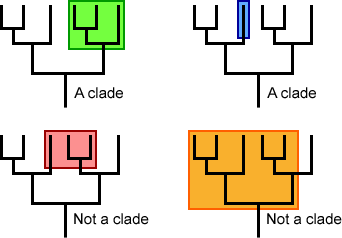
see how a clade just means all of the organisms from one branch off of a common ancestor? aka an ancestor and all of its descendants? the one on the bottom left is not a clade because it includes an organism from a different ancestor. the bottom right isn’t a clade because it excludes one from the same ancestor.
for example on this canidae phylogenetic tree, if you identify as the 5.1 cladotherian, then you’re all the south american species and wolf-liked canids, but NOT the red-fox like species or the island fox and gray fox. if you’re a 3.0 cladotherian, then you only identify as a maned wolf and bush dog. and if you’re 8.8, you’re all of them!
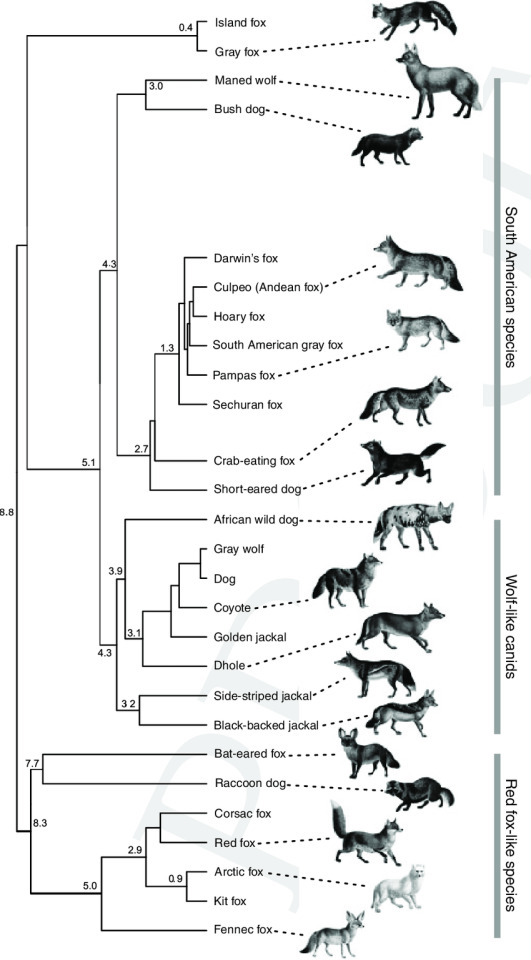
so in this tree of the bovidae family, the caprini tribe is under the caprinae subfamily (like a subgroup of bovines). on some trees they are considered under the subfamily antilopinae, and often use caprini tribe as part of the antilopinae subfamily. it seems like “caprini tribe” and “caprinae subfamily” are sometimes synonyms depending on which taxonomic tree you’re looking at. BUT some classify caprini as an even smaller group (tribe) underneath the caprinae subfamily, which seems to be most common.
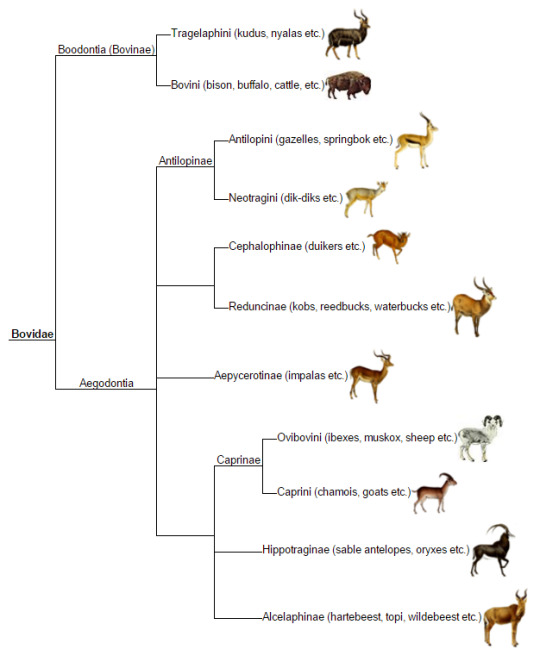
so if you identify as all ibex, sheep, tahr, tur, goats, and chamois, you’re a caprinae cladotherian! if you identify as all sheep, goats, and tahrs, you’re a caprini cladotherian! (genus is much more specific and would only include all goats (“capra”), or all sheep (“ovis”), for example).
(i also think this tree mistakenly put sheep in ovibovini instead of caprini. almost all sources say they are caprini)
you do not have to listen to me at ALL if you don’t want!! i just now researched this about caprines, but i do already have an understanding of toxonomy :) use whatever terms feel comfortable of course
Grrrr you know what brothers me??
Not knowing enough about taxonomy. Like wtf is a subfamily?? Or a tribe?? How am I going to know what alterhuman lables to use... 🤨
I know it doesn't truly matter if someone lables themselves a wolf cladotherian or genotherian cause in the end, we all know what they mean. That they identify as all wolves
But I care. I love lables and I wanna use the "correct" one!!!!! Rrarararaaaaaa
Like am I a caprini cladotherian? Or a genotherian? Or am I caprinae clado??
What even is the difference between caprini (tribe) and caprinae (subfamily)
Does cladotherian even include subfamilies??
Aaaa 😭😭😭😭
77 notes
·
View notes
Note
Hi! I saw your post about the tiefling and wanted to ask: is a shofar from a dragon or an extinct animal, like a ram's ancestor, kosher?
Oh! This is a fun one.
Starting with the easier one -the ancient proto-sheep. But first, I would like to note that I am neither a biologist nor a rabbi, and while I have consulted (albeit minimally) with both for the making of this post, I am not the best source. I can provide links to some useful reading, but tumblr being tumblr, with the link-eating that that entails, I will not be putting the links in the post itself.
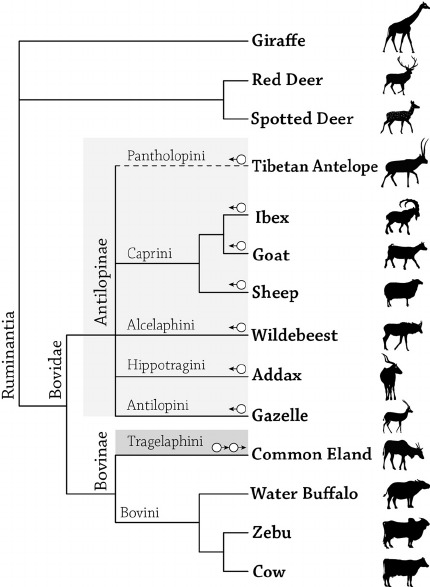
This is the family tree map of the suborder Ruminantia.
As previously established, sheep are valid sources for a shofar. So too are goats and ibices (if I'm going to pretend to be scholarly, I'm going to use the technically-correct Latin plural) -the mishna even specifically addresses ibex horn as a possible source. Thus if our proto-sheep is still within tribe Caprinae, it is a valid source for a shofar.
What I did not address on the other post is that kudu (and gazelles, oryxes, etc) are also acceptable source animals for shofars. Antelopes, like bovines and caprines, have horns, rather than antlers. The requirement for the shofar is that it be a horn, not a bone -that the bone be covered with a keratin sheath. We can thus move further backwards, and authorize any ancestor still within sub-family Antilopinae.
And here is where we need to take a step out of modern science. The laws of kashrut predate genomics, and are often more rooted in morphology than phylogeny. A whale is not an unkosher animal, it is an unkosher fish, because it is fully aquatic. A bat is not an unkosher animal, it is an unkosher bird, because it is a warm-blooded flying creature.
Halachically speaking, if it looks like a cow and acts like a cow, and has the general criteria we associate with a cow, it's a cow. And cows are not acceptable source animals for shofars.
So if we move further back and reach a common ancestor in the family Bovidae, whether it's an acceptable source for a shofar depends on how cow-shaped it is. An aurochs, for instance, is a cow. While I was unable to find any sort of artistic rendering of the presumed last common ancestor at the divergence of Bovinae and Antilopinae, the earliest bovid I could find was Eotragus sansaniensis, which definitely seems closer in shape to an antelope than a cow. It is thus theoretically possible that an ancestral species in Bovidae might be permissible, with more cow-shaped bovines being specifically set aside from the rest of their family -in much the same way that we colloquially apply the term "reptile" to all non-bird modern diapsids. If that is the case, we would then move backward to the last common ancestor of bovines and cervines in suborder Ruminantia. (We might then be able to move forward along the deer tree until antlers diverge from horns, but that is not an ancient sheep, it's an ancient deer.)
We've got our rules on animals. Now we look at the shofar itself. Optimally, the shofar is curved, rather than straight. A straight shofar meets the technical requirements, but if you want to be as stringent as possible, a curved shofar is better. (That said, eland and gemsbok shofars are incredibly striking.) Per the mishna, even ibex horns are considered too straight to count as curved for this particular discussion -and ibices are specifically discussed as an acceptable source. (We used to use shofars for more purposes than we do today. There was a discussion about when to use the straight one vs the curly.)
Now, given that the shofar-making process usually involves some degree of straightening it in order to hollow out the mouthpiece, there is room for debate here. There are those communities and individuals who prefer striking or resonant shofars, and thus accept the larger ones obtained from various antelopes. There are also those communities that ban even a minimal amount of straightening of a ram's horn. Once we're arguing specific stringencies with common precedent for the lenient opinion, though, I think we can say we're in the clear for permissibility.
However. The previous post mentioned the issues with lacquering and otherwise decorating a shofar, which gets into another concern. Namely, the horn being used cannot possess any cracks or breaks from the end of the mouthpiece until one is past the minimum required length for a shofar.
And, unfortunately, old bones that have been around for millennia tend to have some wear and nicks on them, often of the sort that would invalidate a shofar for use.
So in conclusion, one can use the horn of any proto-sheep still within Ruminantia, unless they were too cow-shaped before diverging within Bovidae, in which case, one can use the horn of any proto-sheep within Antilopinae. But it must have either been phenomenally well-preserved, or the proto-sheep must have lived close enough to contemporaneously with the maker of the shofar that the horn has not sustained damage in the interim -ie, this must be a story involving time travel, cloning, or some sort of alternate history situation.
This is long enough already, so I will reblog with my thoughts on dragons in a separate post.
#my biologist consultant has requested that I point out that there are extinct non-diapsid reptiles#but recognizes the point I am making#my rabbi consultant is just amused by the discussion#Silamy likes to ramble#longpost#speculative halacha
22 notes
·
View notes